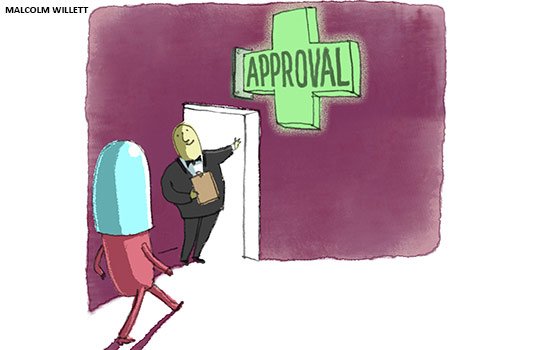 In the late 1980s, AIDS activists stormed the headquarters of the US Food and Drug Administration (FDA) with a message that the FDA’s drug approval process was, simply put, killing people by blocking the approval of new treatments. One protester’s shirt read: “If I die of AIDS—forget burial—just drop my body on the steps of the FDA.”
In the late 1980s, AIDS activists stormed the headquarters of the US Food and Drug Administration (FDA) with a message that the FDA’s drug approval process was, simply put, killing people by blocking the approval of new treatments. One protester’s shirt read: “If I die of AIDS—forget burial—just drop my body on the steps of the FDA.”
Among the demands was an ultimatum to shorten the approval process. Congress reacted and in 1992, under the Prescription Drug User Fee Act (PDUFA), institutionalized the FDA’s ability to offer expedited regulatory review under a new mechanism called “priority review.” For new drug applications granted “priority review,” the FDA aims to complete its review within six months instead of the standard 10 months.
Since 1992, three additional mechanisms were added—”fast track,” “accelerated approval,” and “breakthrough therapy”—all aimed at speeding drugs to market. While priority review focuses on speeding up the FDA’s actions, fast track and accelerated approval expedite matters by reducing evidence development requirements (for example, by permitting the use of surrogate measures instead of clinical outcomes in clinical trials).
But the programs have long attracted concerns that speed is coming at the cost of safety, putting patients at increased risk of being prescribed insufficiently studied, unproven, or unsafe drugs.
Over the years, several studies have attempted to provide empirical insight into the relationship of speed and safety, and a new analysis published in The BMJ by Mostaghim and colleagues finds that drugs approved through expedited regulatory pathways—as compared to drugs approved through regular pathways—were associated with a 7% to 106% higher rate of change to two important sections of drugs’ safety labeling in the postmarketing period: boxed warnings (formerly known as “black box warnings”) and contraindications. And the changes to boxed warnings were not in the desired direction: less than 5% of them described reduced risk to patients.
The results raise the question of whether regulators were right to allow the drugs to be expedited to market. With shortened review timelines (the vast majority of expedited drugs received the faster six month priority review), did regulators rush to complete their reviews and overlook safety issues that were subsequently picked up in the postmarketing period? If so, clinicians began prescribing the drug under faulty assumptions. This would seem to only compound a pre-existing problem: both clinicians and patients already tend to overestimate efficacy and underestimate harms.
However, there are more forgiving ways to interpret the results. Rather than indicating a problem, one could argue that the findings are actually a sign that the system is working as it should. The increased rate of safety related label changes associated with expedited pathway drugs is a good thing, reflecting the additional attention and vigilance that the FDA devotes towards these drugs. More information on labeling should be celebrated, not seen as a problem. This explanation is consistent with some of the underlying principles of the European Medicines Agency’s “adaptive pathways” (criticized in The BMJ).
But there’s no particular reason to think that the FDA devoted additional resources to following all expedited drugs post-market; the priority review pathway does not require additional post-market monitoring. But even if it were the case, it does not tell us whether the FDA was correct to send through drugs through expedited pathways in the first place. According to the authors, most drugs today qualify for one of the FDA’s expedited pathways. But what is the evidence that the public is on board with the notion of sacrificing safety for speed?
A Harvard/STAT poll of 1006 US adults last year found that the majority of people do not want drug standards changed to make approvals faster. Fifty eight per cent opposed the measure while 38% favored it. The results fly in the face of a common refrain that “patients are willing to accept more risk.”
It is time we hear from the FDA. Mostaghim and colleagues’ results are consistent with those of Downing and colleagues earlier this year, and Carpenter and colleagues nearly a decade ago. To my knowledge, that 2008 analysis was the only one to evoke a response from the FDA. The group found that drugs approved within two months of the FDA’s PDUFA-inflicted deadline were more likely to be withdrawn from the market for safety reasons (as well as more likely to carry black box warnings), again raising concerns about the dangers of “rushing.” The FDA countered with its own analysis (incidentally, an irreproducible analysis), which argued that the “somewhat greater rate of withdrawals” in just-before-deadline approvals “could easily represent a chance finding.”
But that was 2008. The FDA should publish an updated analysis with a decade’s more worth of data. They may discover that their findings may now be statistically significant, too. And if so, it’s time the FDA explains exactly why it is acceptable to speed drugs to market if speed comes at the cost of safety. Don’t all patients, regardless of their situation, want FDA approval to indicate durable evidence that benefit outweighs risk?
Peter Doshi, associate editor, The BMJ.
Competing interests: See http://www.bmj.com/about-bmj/editorial-staff/peter-doshi
